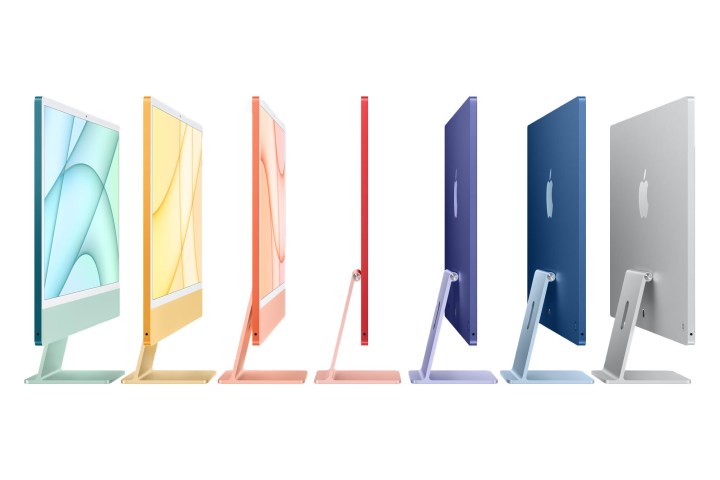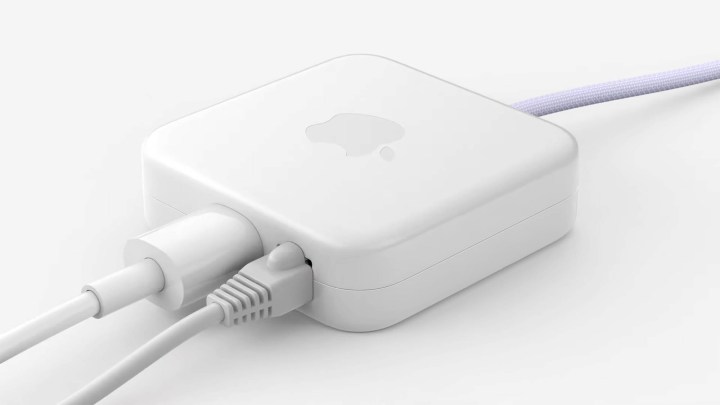
Apple’s new iMac (2021) was an exciting introduction for the company when the all-in-one desktop was launched earlier this year at the Spring Loaded event. Apple’s desktop ushered in an entirely new design that was made possible, as company executives like to point out, by the transition from Intel processors to Apple’s in-house M1 silicon. And while the MacBook Air already transitioned to Apple’s custom processor late last year, it retained the same stale design that the company had been using for years.
With rumors that an M2 processor could launch this year, a new MacBook Air appears to be imminent, and Apple could borrow three key design ideas and features from its iMac to knock the redesign of its most affordable laptop out of the park. The iMac reintroduced us to some classic features — like colorful designs and the beloved MagSafe charging port — as well as an entirely new design that’s thinner, lighter, and more angular.
Colors: What’s old is new again

Aside from the change to Apple’s in-house silicon, the biggest — and most noticeable — change to the iconic all-in-one iMac desktop is that it is now available in beautiful, bright, and bold colors. This is a stark departure from the silver-and-white design ethos Apple had been using in recent years that celebrates the desktop’s colorful past: The blueberry iMac with its CRT display was equally as stunning as it was playful for its time.

With the new iMac, Apple’s desktop comes in hues that are borrowed from its colorful logo of yore, and we expect the MacBook Air to follow suit.
If early rumors that whimsical shades could be coming to the MacBook Air pans out, this would mean that Apple’s least expensive laptop series would be playing tribute to the iBook, with its colorful edges and curvy silhouette.

Trusted leaker Jon Prosser recently predicted on his YouTube channel Front Page Tech that a new M2-powered MacBook Air could come in new colorful hues, according to MacRumors. Prosser’s renders revealed an ultraslim design in a unibody aluminum housing with a more angular aesthetic. The newly redesigned MacBook Air would also usher in Apple’s unannounced M2 silicon, which should be even more powerful than the current M1.
Compared to the old iBook G3, the MacBook Air’s colors are lighter and more pale, according to the early renders. And like the iMac, the Air could get a white bezel — instead of the black bezels on the current model — surrounding the display to keep the the area around the display more neutral and less distracting.
If Apple’s design trends on the iPhone and iPad serve as indicators, Apple would likely continue the same muted color choices — silver and space black — on its Pro line of MacBooks, following the idea that the duller colors are more appealing to professionals and creatives. This would free Apple to be more playful on its consumer offerings. The MacBook Air, after all, is marketed at students.
The never-ending quest for slimness

Apple has been on a historical quest — minus some few exceptions — to make each successive generation of its products slimmer than the previous one. With the late 2020 MacBook Air, however, Apple opted to keep the same design as the prior generation in order to focus its efforts on rearchitecting the internals to accommodate the new M1 processor.
And Apple’s conservative efforts paid off — the M1-powered Air got nearly twice as much battery life as the exiting Intel model due in large part to the power efficiency of the underlying ARM architecture. However, to keep things fresh, there has been speculation that the 2021 MacBook Air could introduce a major redesign.

Alongside the new colors, we expect the MacBook Air to get slimmer — a lot slimmer, in fact — than the current M1 model. On the iMac, the entire computer got thinner. For comparison, Apple’s all-in-one desktop is about the same thickness as the first-generation iPhone! The iMac measures just 0.45-inch thick, compared to the 0.63-inch MacBook Air and 0.46-inch OG iPhone. We expect Apple to make its next Air a lot slimmer, and the laptop could borrow from the iMac, iPad Pro, and iPhone’s more angular design language.

According to Prosser’s predictions and early Air renderings, the laptop would eschew the tapered and wedged design in favor of a uniformly flat and thinner profile.The MacBook Air may also do away with Apple’s historic use of black keys on the keyboard in favor of an all-white keycap design that’s similar to the iMac.
Slimming down the MacBook Air could result in the laptop’s class-leading battery life taking a hit. But even if the stated 18 hours of battery life gets trimmed down to 12 or 15 hours, that’s still more than plenty for a full working day. And the power-efficient core could also introduce some fast-charging technology — borrowed from the iPhone — to offset the laptop’s reduced power stamina in a slimmed-down design.
MagSafe: Magnetic attraction

The redesigned iMac brought back a beloved feature for Mac fans: MagSafe charging. Though Apple had done away with MagSafe when it switched to Thunderbolt 3 and USB-C ports on its notebook design, MagSafe made a reappearance on the iPhone 12 as part of Apple’s accessories ecosystem, and the feature also made its way to the iMac.
On the new iMac, MagSafe’s magnetic connection is used to securely and quickly latch the power cord to the rear of the desktop, and the MagSafe power brick can also accommodate an Ethernet jack.

While a magnetic cable certainly simplifies life and looks just plain cool on a desktop, it may serve more utility on a laptop. Once restrictions with the global pandemic ease up, executives working from coffee shops and airports may have to plug their laptops in at outlets further away from where they’re seated, increasing the potential that someone passing by could trip on the power cord.

A normal power cord that’s plugged into a laptop may not be able to quickly unlatch, and the force could result in the notebook flying to the ground. With a magnetic connection, like Apple’s MagSafe system, the cable could be quickly unlatched if it’s tripped over, and the laptop would remain safe.
Bloomberg’s Mark Gurman had previously predicted that MagSafe’s reintroduction on Apple’s laptops could also bring faster charging speeds.


